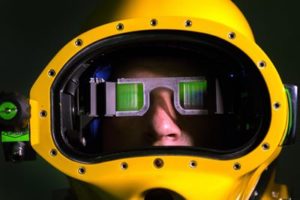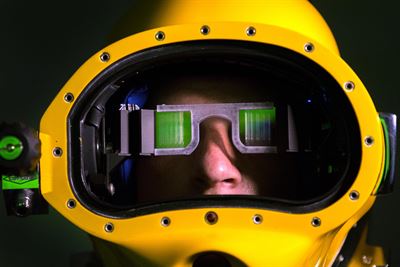The once-ribbing term “four-eyes” now secures a coolness factor, thanks to a team of Navy engineers who have developed a high-resolution, see-through, heads-up display embedded directly inside a KM-37 Navy dive helmet to keep its users safer, more efficient and more effective underwater.
Project Manager Dennis Gallagher, an engineer with the underwater systems development and acquisitions branch special optics lab, said he and his team have developed a next generation, futuristic, 3D-printed prototype that might even evoke the envy of Ironman.
Meet DAVD, also known as the Divers Augmented Vision Display. Years in the making, a plastic waveguide houses binocular-style “smart glasses,” featuring a tiny micro-display smaller than a postage stamp and ready to receive a variety of critical topside data that assists divers working in even the most austere and low-visibility underwater conditions.
Once a mere concept based on a need, DAVD has matured into an operational and testable prototype that Gallagher said is so far earning rave reviews from the Navy, joint and allied forces’ dive communities.
“Unlike recreational diving, where you’re in the Bahamas [and] it’s crystal clear and it’s beautiful, military diving is almost [always] dark, pitch-black water. You’re working in diving in salvage, ship husbandry — very dangerous, difficult environments,” Gallagher said. “So you can’t see life-support information, critical sensor data that you need. Your gauges are almost useless down there, because you cannot see them in front of your face.”
The technology, Gallagher said, is a culmination of display capabilities, much of which the Air Force has used for years to send and receive information.
An Augmented Reality
“What we can send on that heads-up display is literally anything the topside dive supervisor has on the computer,” Gallagher said of the point-of-view, video game-style device. “It can be sonar or sector scan that’s a top view of what the salvage area looks like. We can even send a 3-D augmented reality overlay on an area.”
The diver, he added, can see the wreck, the object of interest, even him or herself navigating to the target area. The system works through voice commands, which can carry a diver’s request for text messages, drawings, pictures, and video placed anywhere on the screen. He or she can also turn the entire system off and return to see-through mode if necessary.
Gallagher noted that DAVD even has favorable outreach beyond the military, including commercial and first-responder dive realms, including law enforcement.
“[The police divers] had people who lost their lives — they couldn’t see their gas pressure, because [the visibility] was so bad when they were trying to do a body recovery,” Gallagher said. “So this kind of thing has tremendous outreaching capability.”
How It’s Made
How the DAVD is made seems to have just as storied a journey as what it can already help divers achieve. Gallagher said he knew the lab would need to bring forth the technology as quickly and inexpensively as possible, which prompted concept development through 3-D models. “We can take our mechanical engineering models, and electrical engineering models, and literally email it across the base to the 3-D printing shop — they make the versions of them there — then we can do the final assembly, put it in the lab and start testing it at lightning speed for very little money.”
Chuck Self, head of the Navy Surface Warfare Center Panama City rapid prototyping shop, said making something from nothing is all in day’s work, as he and his team are the first stop for designers with prototypes and initial articles.
 Self’s work puts 3-D printed models in hands of engineers, enabling them to quickly conduct design reviews, find flaws in parts, make revisions, and get a product to market much faster. Additionally, the prototyping shop partners with all other warfare centers in a 3-D printing, or additive manufacturing, working group, Self explained.
Self’s work puts 3-D printed models in hands of engineers, enabling them to quickly conduct design reviews, find flaws in parts, make revisions, and get a product to market much faster. Additionally, the prototyping shop partners with all other warfare centers in a 3-D printing, or additive manufacturing, working group, Self explained.
“This working group’s main goal is to help implement additive manufacturing to the Navy in a smart, safe, effective way,” Self said, adding that qualification, certification, and workforce development are all major factors for the Navy to approve additive manufacturing as an acceptable process. “The goal is to approve a process so that it doesn’t have to be a case-by-case situation and we can certify the part to go for fleet use,” he said.
Additive manufacturing uses state-of-the-art technology to instruct computer-controlled machines to print parts in a layered format, Self said. “We have nothing to start with, and we add material layer by layer until we’ve achieved that final part,” he added.
The technology is not as new as much of the public might think. Self said the Panama City lab has been leveraging 3-D printing for close to 20 years, and the technology originated about 25 years ago. “During that time, you’ve seen a massive maturation of the process,” Self said.
Putting DAVD to Use
Perhaps the rubber really meets the road when the concept ripens to practical use in the fleet.
Navy Petty Officer 2nd Class Chris Lambertsen, Navy Diving and Salvage Training Center dive medical technician, said he and his colleagues look forward to wider use of DAVD.
“The heads-up display where you can find your compass and heading would aid any diver and would help make diving efficient, keeping your bottom time at a minimum,” Lambertsen said. “It could help not only a lost diver find himself, but would help his dive buddy find a lost diver and ultimately save lives.”
He also shared his personal stake in the technology and diving in general.
“I dive because I love it,” Lambertsen said. “I’m lucky enough to have been here at the Navy Surface Warfare Center to see some of the best and newest diving technology come through and have the opportunity to be part of some of the testing and development for it.”
Navy Petty Officer 1st Class Steven Starner, also a military diver and DAVD prototype user, recalled a mission in 2014 in which the priority was to recover a piece of history from the Civil War vessel CSS Georgia. Starner and his team faced low visibility, high currents and limited time to get the job done.
“On the bottom of the Savannah River, everything was done by feel. I was able to see maybe 6 to 8 inches in front of my face, and anything more than that was nothing but a blur and darkness,” Starner recalled. “DAVD would’ve helped to decrease the amount of time it took to complete this mission.”
Today, DAVD testing will continue with ongoing enhancements, capabilities and interoperability, progress made possible by the creative freedom the Navy allows, Gallagher said. But he also stressed that creative freedom isn’t his only motivation in going to work each day. He recalled briefing about one of his earliest diver display systems to a group of service members, newly returned from Iraq and Afghanistan. He remembered how eager they were to use the technology.
Putting it all into perspective, he went back to his office and wept.
“I realized that I complained that the coffee was cold at the mess and these guys have been out doing these kinds of things, trying to get back to their families,” Gallagher said. “That changed my entire outlook – whatever I do could literally make a difference in that person in theater getting back, … because the next crazy idea we have could do something like that. I’ll stay and work the weekend for that one.”


